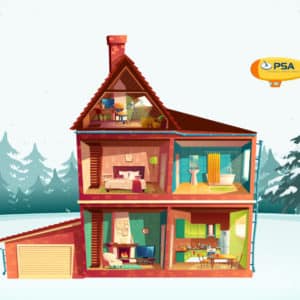Don’t Let A Flash Flood Take You by Surprise: Tips to be Prepared
Posted in: Personal Insurance
Floods are the most frequent and costly national disasters that can cause significant economic losses. But did you know, that flash floods can be even more devastating? It is mostly because the speed at which water accumulates to dangerous levels can often catch unsuspecting people by surprise.
Every summer, we see several storms and hurricanes causing flash floods. Hence, it’s incredibly important to understand the cause and nature of flash floods including potential dangers due to rapid stream rise. If you prepare in advance for a flash flood, but are not aware of safety best practices when it is imminent or happening, you can be more at risk than during a regular flood.
Flash Flood and its Dangers
Flash flooding occurs when heavily rains on either saturated or very dry soil with poor absorption ability or in low-laying areas. It can form within just minutes of high intensity rain with little or no advance warning. This is especially a problem when there are multiple slow moving storms in the same area.
Flash flooding is extremely dangerous because water gathers quickly and moves fast – often carrying debris, or causing mud slides, which can trap unsuspecting people who underestimate or are not aware of the flash flood’s risks. Ultimately it can claim lives, damage houses, roads and property.
Best Practices to be Prepared
There a number of things you can do to prepare for a flash flood. But most importantly, you should be aware of practical steps to take when a flash flood is imminent.
Preparation in Advance
- Keep a stockpile of emergency building materials including: plywood, plastic sheeting, lumber, nails, hammer and saw, pry bar, sand, shovels and sandbags.
- Purchase a battery powered NOAA Weather Radio with a tone-alert for updated emergency information.
- Discuss with your family where everyone should go if they have to leave due to hazardous storms.
- Place insurance policies and valuables in a safe-deposit box to help prevent flood damage.
- If possible, raise your furnace, water heater, and electric panel to higher floors if they are currently in areas that could be flooded.
- Install check valves to building sewer traps to prevent flood water from backing up into the drains of your home.
- Seal walls in basements with waterproofing compounds to avoid seepage through cracks.
- Download an app on your phone such as the Red Cross’s app specifically designed for flood related warnings and tips, or for a more general weather alert you may consider any free weather alert app.
- Discuss your insurance options with your agent. You’ll likely need a flood insurance to protect your home and property as flash flood is often not covered by your homeowners’ policy. Also, make sure you have comprehensive coverage for your vehicle and sufficient life insurance to take care of your family in case of any casualties.
When a Flash Flood is Imminent
- Fill bathtubs, sinks and water bottles with clean water in case of contamination or service disruption.
- Fill your vehicle’s gas tank in case of evacuation.
- Move furniture and valuables to the highest point in your house to help avoid damage.
- Bring your outdoor furniture and other belongings inside.
- Tune into your local station or the National Weather Service alerts for updates for your specific area:
- A Flash Flood Watch means that there is a high possibility for a flash flood, and you should be ready to act at a moment’s notice and evacuate if needed, especially if you are in a flood-prone area because it can happen incredibly quickly.
During a Flash Flood
Be aware of areas that are considered high risk in the event of a flash flood and try avoiding them, including:
- Close proximity to a stream;
- Highly populated areas without sufficient ground for absorbing heavy rainfall;
- Construction sites including buildings, parking lots and/or highways;
- Low spots such as underground parking lots and basements;
- Overwhelmed storm drains.
- Avoid contact with any flood water as it could be contaminated with raw sewage, oil or gasoline or could be charged from electrical wires.
- If you are on foot, be aware that you could lose footing or be swept away in just six inches of moving water.
- If you’re swept away by the water:
- Try to make sure your feet are pointed downstream;
- Make every effort to go over obstacles rather than under them.
- Almost half of the fatalities caused by a flash flood occur while driving. Just a foot of water can float most vehicles, while rapidly moving two feet of water can sweep a car or even an SUV off a bridge.
- Do not drive into flooded roadways or through flowing water of unknown depths.
- If your vehicle is flooded, roll down the window and try getting to a higher ground immediately.
- If your window won’t open, allow the car to fill up with water, which will then allow you to open the door to swim to a safer place.
- Listen to storm and flash flood updates on your mobile device or radio:
- A Flash Flood Warning means that it either is already occurring or is imminent, and you should move to a higher ground immediately.
- If you need to evacuate, follow the instructions of local authorities who are the most informed about the rapidly changing conditions in the affected areas.
After a Flash Flood
- Throw away food that could have been contaminated by bacteria from the flood.
- If entering buildings after flooding, especially if there is still water inside, be extra careful because the integrity of the foundation can be compromised:
- Inspect the building for structural issues to make sure it is safe to enter and still habitable, which would include checking for hanging drywalls and ceilings, cracked floors and the stability of staircases.
- Fire is the most frequent hazard after a flood, which is often caused by gas leaks or electric damage in affected buildings:
- If you smell gas, open a window and leave promptly. Make sure to contact your local authorities or utility company.
- Similarly, if you notice a flooded electrical circuit/appliance, don’t step into the water because you could be electrocuted. Contact your local authorities.
- Flood can also damage sewage and waterlines. If you suspect damage, avoid using your toilet, or drinking water from the tap and contact your utility company. Boil drinking water if it is questionable, or you can melt ice for drinking that has not been in contact with flood water.
- During a flood a lot of small animals can be flushed out and swept into your home. Make sure you use a stick to poke through debris to avoid bites.
- If your basement is flooded, pump out the water gradually over several days, otherwise the saturated soil from outside could collapse your basement walls.
- Make sure you document any property damage by taking pictures and making a list for insurance claims.
For other helpful tips on flood preparation including insurance options, please check out Flood Preparation & Insurance: What Homeowners Need to Know. To discuss flash flood coverage specific to your needs, contact me at cmorsberger@psafinancial.com.



